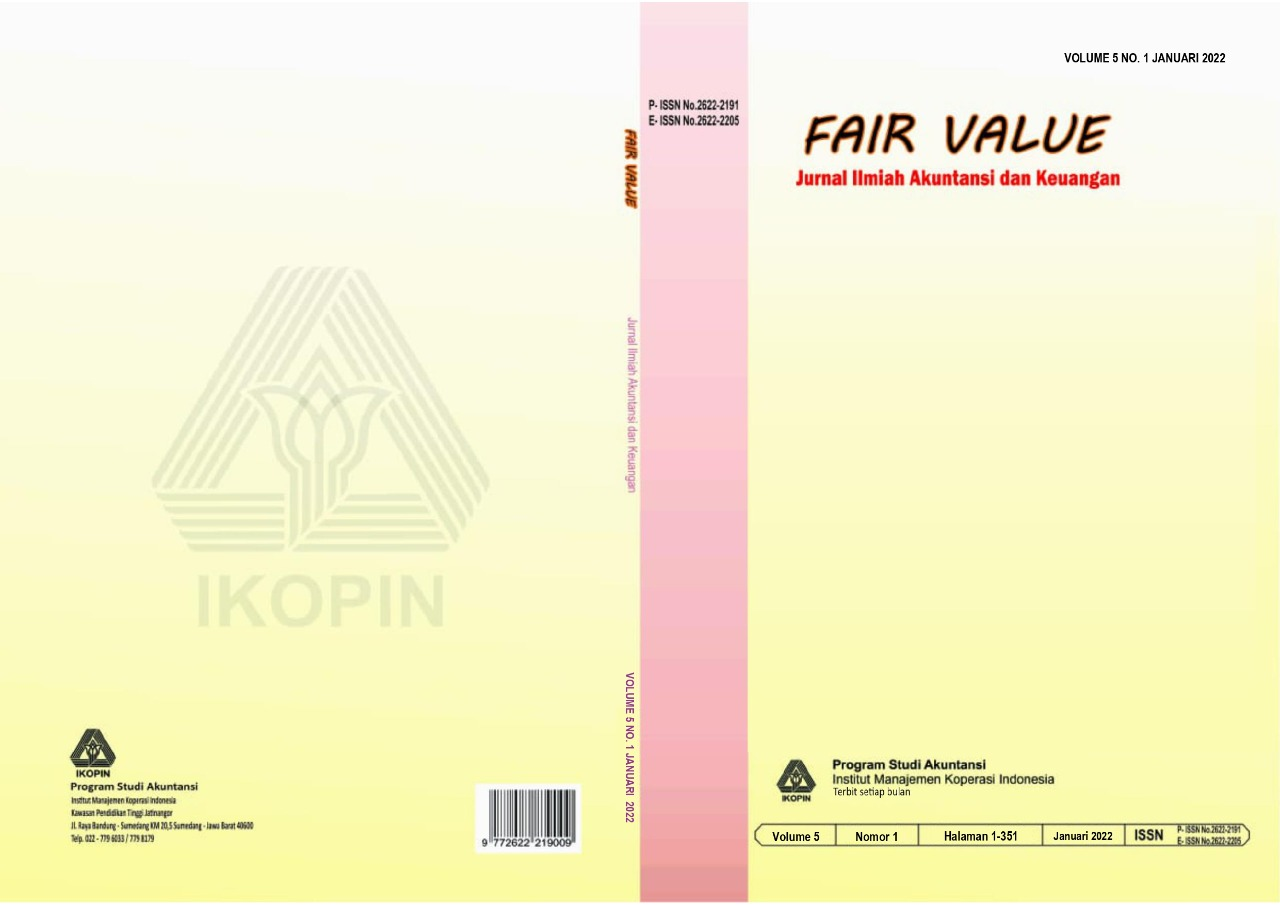Pengaruh profitabilitas dan likuiditas terhadap peringkat obligasi
Main Article Content
Abstract
One form of funding that can be done by a company is by issuing bonds. This research was conducted with the aim of testing the significance of the influence of profitability and liquidity on bond ratings in the property, real estate and construction sectors. When investors are interested in buying bonds, there are several things they must pay attention to, one of which is the bond rating as a reference for the company's performance in paying its debts. The profitability bond rating is measured using the Return On Assets proxy, while liquidity is measured using the Current Ratio proxy and the rating agency used is PT Pefindo. Sampling was carried out by purposive sampling. The data analysis method uses multiple linear regression using Eviews 10. The research results simultaneously show that Profitability with the Return On Assets proxy has an effect and Liquidity with the Current Ratio proxy has an effect on bond ratings. Simultaneously Profitability and Liquidity influence bond ratings. So, it can be concluded that the higher the level of profitability and the lower the company's liquidity, the higher the bond rating will be.
Article Details
References
Amran, H. (2016). The determinants of corporate bond rating in Indonesia. JRMSI - Jurnal Riset Manajemen Sains Indonesia, 7(2), 241–258. https://doi.org/https://doi.org/10.21009/JRMSI.007.2.03
Azani, P., Khairunnisa, K., & Dillak, V. (2017). Pengaruh likuiditas, leverage dan pertumbuhan perusahaan terhadap peringkat obligasi. EProceedings of Management, 4(1), 387–394. https://openlibrarypublications.telkomuniversity.ac.id/index.php/management/article/view/4502
Brigham, E. F., & Houston, J. F. (2015). Fundamentals of financial management, concise 8th edition. Mason, OH: South-Western, Cengage Learning.
Hasan, D. A., & Dana, I. M. (2018). Pengaruh profitabilitas, likuiditas, maturity dan jaminan terhadap peringkat obligasi tertinggi pada sektor keuangan di Bursa Efek Indonesia. E-Jurnal Manajemen Unud, 7(2), 643–673. https://doi.org/https://doi.org/10.24843/EJMUNUD.2018.v7.i02.p04
Hermuningsih, S. (2013). Profitability, growth opportunity, capital structure and the firm value. Buletin Ekonomi Moneter dan Perbankan, 16(2), 115–136. https://doi.org/https://doi.org/10.21098/bemp.v16i2.440
Jones, R. C. (2014). Making better (investment) decisions. The Journal of Portfolio Management, 40(40), 128–143. https://doi.org/10.3905/jpm.2014.40.2.128
Lumoly, S., Murni, S., & Untu, V. N. (2018). Pengaruh likuiditas, ukuran perusahaan dan profitabilitas terhadap nilai perusahaan (Studi pada perusahaan logam dan sejenisnya yang terdaftar di Bursa Efek Indonesia). Jurnal EMBA: Jurnal Riset Ekonomi, Manajemen, Bisnis dan Akuntansi, 6(3), 1108–1117. https://doi.org/https://doi.org/10.35794/emba.6.3.2018.20072
Manalu, A., & Silalahi, D. (2023). Pengaruh struktur modal, profitabilitas, likuiditas dan aktivitas terhadap peringkat obligasi perusahaan swasta non keuangan yang diperingkat PT. Pefindo tahun 2017-2021. KUKIMA: Kumpulan Karya Ilmiah Manajemen, 2(1), 12–21. https://ejournal.ust.ac.id/index.php/KUKIMA/article/view/2753
Melani, K. S., & Kananlua, P. S. (2013). Analisis pengaruh rasio keuangan terhadap peringkat obligasi perusahaan manufaktur yang terdaftar di Bursa Efek Indonesia. Jurnal Ilmiah Manajemen, 8(2), 45–56.
Pradnyawati, S. O. (2022). Faktor-faktor keuangan dan peringkat obligasi. Accounting Profession Journal (APAJI), 4(1), 19–27. https://doi.org/https://doi.org/10.35593/apaji.v4i1.36
Pramesti, D. S. P. (2022). Pengaruh leverage dan profitabilitas terhadap peringkat obligasi. Fair Value: Jurnal Ilmiah Akuntansi dan Keuangan, 4(10), 4266–4273. https://doi.org/https://doi.org/10.32670/fairvalue.v4i10.1658
Saputri, D. P. O. S., & Purbawangsa, I. B. A. (2016). Pengaruh leverage, profitabilitas, pertumbuhan perusahaan, dan jaminan terhadap peringkat obligasi sektor jasa di Bursa Efek Indonesia (Thesis). Udayana University.
Tandelilin, E. (2017). Pasar modal manajemen portofolio & investasi. PT Kanisius.
Widowati, D., Nugrahanti, Y., & Kristanto, A. B. (2013). Analisis faktor keuangan dan non keuangan yang berpengaruh pada prediksi peringkat obligasi di Indonesia (Studi pada perusahaan non keuangan yang terdaftar di BEI dan di daftar peringkat PT Pefindo 2009-2011). Jurnal Manajemen Maranatha, 13(1), 35–54. https://doi.org/https://doi.org/10.28932/jmm.v13i1.141
Wijayanto, S. (2015). Strategi jitu investasi obligasi korporasi. Elex Media Komputindo.

